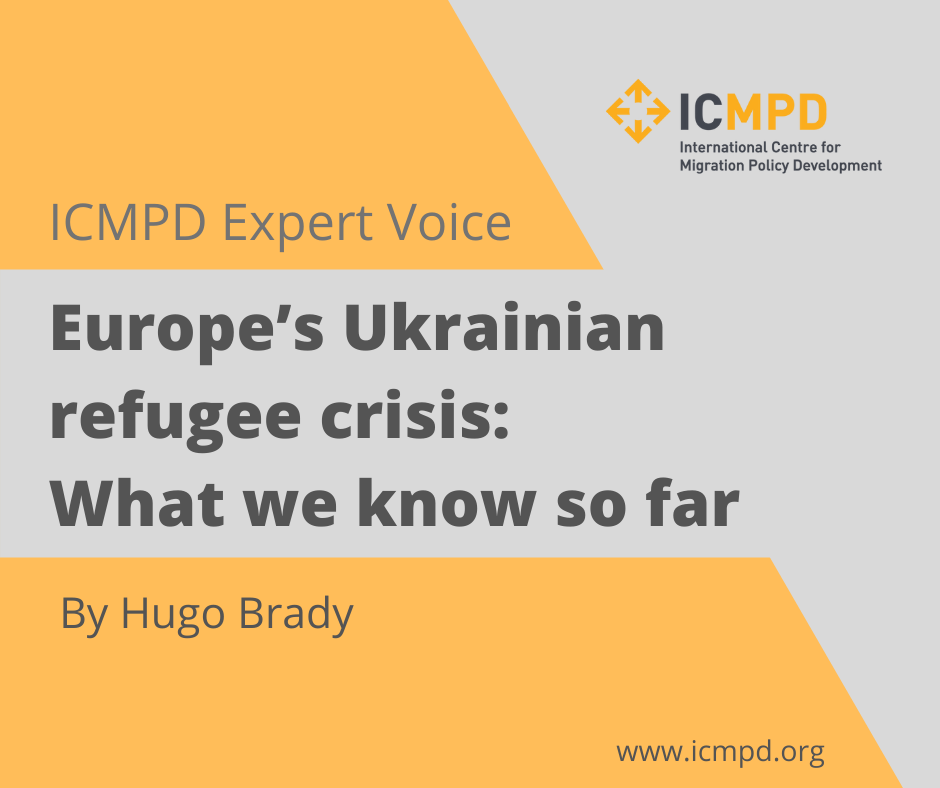The EU is witnessing an influx of refugees from Ukraine on a far greater scale than in 2015-2016. What will be the status of the new arrivals; what can be done for non-Ukrainians trying to escape the conflict; and what does it mean for EU asylum policy in the medium term? These and other questions are addressed in the new ICMPD Expert Voice prepared by Hugo Brady, a senior strategic adviser at ICMPD. The Expert Voice was published on 28 Fenruary 2022. It is also available in Russian and Ukrainian languages.
One million refugees set to enter the EU in a week
By Sunday 27 February, 370,000 Ukrainian, EU and third country nationals had crossed into neighbouring EU countries, often in weather of minus 10 degrees or lower:
- Poland (213,000)
- Hungary (78,000)
- Slovakia (26,000)
- Romania (97,000) (34,000 directly from Ukraine, 63,000 via Moldova)
By Monday, overall departures from Ukraine were at 500,000 and rising, with UNHCR predicting up to 4-5 million people could end up fleeing the conflict.
Central and eastern EU countries are welcoming them
Prior to war breaking out, Poland and Romania prepared basic reception facilities for 1 million people each, Hungary some 600,000 and Slovakia around 50,000. That capacity is likely to be reached very soon. The crisis represents perhaps the greatest logistical challenge ever faced by the eastern states in modern times, one to which they seem to be rising impressively. National militaries are mobilised to help with arrivals and a network of temporary reception centres is established along the EU-Ukrainian frontier. So far one country – Slovakia – has said it request help from Frontex, the EU’s border guard agency, to man the border.
Most will not be ‘asylum seekers’ in refugee camps
Ukrainians do not currently require a visa to enter Schengen countries and can remain for up to 90 days. Visa liberalisation to the EU was granted in 2017 and this is first time ever a country bordering the EU with visa-free status is also at war. Hungary and Slovakia already announced last week Ukrainians will receive national ‘temporary protection’ status. However, a lot of arrivals are likely to eschew refugee status altogether. So far less than 50 have applied for asylum in Slovakia, for example.
EU countries are likely to grant temporary EU protection status, including labour market access, on Thursday
EU interior ministers will meet to decide on a package of crisis response measures, including reprogramming around 200 million euros immediately available for border management support. (A lot more money will be mobilised in the coming weeks.) For the moment, one clear need seems to be the provision of warm clothes and heating equipment, rather than first aid kits, for example.
Most importantly, EU countries will probably agree on the European Commission’s plan to trigger the Union’s Temporary Protection Directive (TPD). This never-before-used legislation was agreed in 2001 after five wars in the former Yugoslavia during the 1990s. It allows for specific, clearly defined group fleeing conflict en masse to receive collective protection status within the Union. This gets around the need to go through lengthy asylum procedures for each person and, critically, gives the new arrivals access to the labour market. Unlike national temporary status, the TPD would also allow Ukrainians to move around the EU to link up with personal networks.
Fears of an irregular migration crisis will remain below the surface
In contrast to 2015, welcoming war refugees from neighbouring Ukraine is popular with Europeans and much will be done to accommodate the new arrivals. Ukrainians have strong linguistic, historical links with their likely hosting countries, and are patently the innocent and unsuspecting victims of an unprovoked conflict where many have paid a heavy price for wanting closer ties to Europe. However, every refugee crisis follows an arc from the initial positive emotions of welcome to frustration over initial challenges and then fear over rising numbers and the sense that open borders and host communities are vulnerable to abuse. There will inevitably be some tensions with local communities during a period of high inflation and heightened security tensions. These are likely to be manageable, however.
Read the whole article on the ICMPD website

